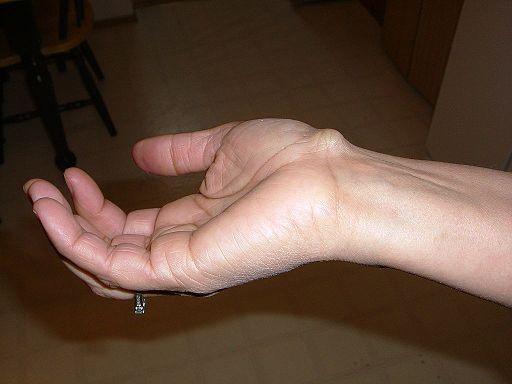Ganglion
Peer reviewed by Dr Toni Hazell, MRCGPLast updated by Dr Philippa Vincent, MRCGPLast updated 11 Aug 2025
Meets Patient’s editorial guidelines
- DownloadDownload
- Share
- Language
- Discussion
A ganglion cyst is a harmless fluid-filled lump which can occur near joints or tendons. They are most commonly found on the wrists or hands. They are harmless but can cause discomfort, pain and weakness. Some people find them unsightly. Usually, no treatment is needed. Sometimes a ganglion can be removed by a small operation.
In this article:
Continue reading below
What is a ganglion cyst?
Wrist ganglion cyst

By GEMalone, CC BY 3.0, via Wikimedia Commons
A ganglion cyst is a small swelling that contains a thick jelly-like material. It looks and feels like a smooth lump under the skin. It is not fully understood how it occurs but most experts think that they occur due to multiple micro-traumas to the area of the body.
A ganglion is usually attached to a joint or tendon, and the fluid inside is a thicker version of the fluid which 'lubricates' the joint and tendon sheaths (synovial fluid).
Where are ganglion cysts found?
Back of the wrist. The most common site for a ganglion to be found is on the back of the wrist. 7 out of 10 ganglion cysts are found here.
Front of the wrist (the same side as the palm). It can also occur on the other side of the wrist. 2 out of 10 ganglion cysts are found here.
Top of foot, ankle, top parts of the fingers. 1 out of 10 ganglion cysts are found here.
Other sites of the body are affected less commonly.
Ganglion cyst symptoms
Swelling. The main symptom is a lump, which is usually very smooth and round.
Size. Their size can vary from being very small (pea-sized) to being larger (plum-sized).
Painful. They can sometimes be painful or tender, particularly if they lie next to a nerve.
Never spread. They never spread to other areas of the body.
Usually when a ganglion cyst is present it is there all the time but sometimes they come and go. 5 out of 10 ganglion cysts disappear completely over time without any treatment.
Your doctor will usually be able to tell if the lump is a ganglion just by examining it. Very occasionally, if the diagnosis is not clear, a scan such as an ultrasound scan or MRI scan may be needed.
Continue reading below
Ganglion cyst treatment
If a ganglion cyst does not cause symptoms it can be best just to leave it alone. However, many people prefer to get rid of them.
Many people have heard of the traditional cure, which is to smash them with a heavy book (tradition holds it to be the family bible). This bursts the cyst under the skin. The fluid is then absorbed into the bloodstream. In some people this works well, but there is a high chance of it coming back (recurring), as the walls of the cyst can reform. It is not usually recommended as there is a risk of injury to the area around the ganglion cyst.
Medical treatment is not always available on the NHS.
Aspiration
In some cases it is possible to suck out (aspirate) the fluid with a needle and syringe. If the jelly-like fluid is very thick this may not work. Also, if it does work, there is a chance that the cyst will recur, as the wall of the cyst is not removed, and the fluid may form again to refill the ganglion. However, in some people it cures the problem. As it is quite easy for a doctor (usually an orthopaedic surgeon) to do, this is often attempted first.
Continue reading below
Surgery
Surgical removal of the ganglion cyst is the most successful cure. This is a relatively minor operation. This is the treatment that is most likely to be permanent but still around 3 cases in 20 will come back.
Patient picks for Lumps and bumps

Signs and symptoms
Lumps
Most lumps are harmless and do not need any treatment. However, it is very important to see your GP if you have any concerns about the lump, or if the lump doesn't disappear within two weeks.
by Dr Hayley Willacy, FRCGP

Signs and symptoms
Neck lumps and bumps
Neck lumps and bumps are common and they have many possible causes. They may arise from the skin or from structures underneath.
by Dr Doug McKechnie, MRCGP
Further reading and references
- Gude W, Morelli V; Ganglion cysts of the wrist: pathophysiology, clinical picture, and management. Curr Rev Musculoskelet Med. 2008 Dec;1(3-4):205-11. doi: 10.1007/s12178-008-9033-4. Epub 2008 Aug 26.
- Ganglion - Clinical guidance; Primary Care Dermatology Society. November 2021.
- Ganglion cysts; British Society for Surgery of the Hand (BSSH)
- BSSH Evidence for Surgical Treatment - Wrist Ganglion; British Society for Surgery of the hand
Continue reading below
Article history
The information on this page is written and peer reviewed by qualified clinicians.
Next review due: 10 Aug 2025
11 Aug 2025 | Latest version

Ask, share, connect.
Browse discussions, ask questions, and share experiences across hundreds of health topics.

Feeling unwell?
Assess your symptoms online for free
Sign up to the Patient newsletter
Your weekly dose of clear, trustworthy health advice - written to help you feel informed, confident and in control.
By subscribing you accept our Privacy Policy. You can unsubscribe at any time. We never sell your data.